Abstract
Böck, August (Purdue University, Lafayette, Ind.), Lia Eidlic Faiman, and Frederick C. Neidhardt. Biochemical and genetic characterization of a mutant of Escherichia coli with a temperature-sensitive valyl ribonucleic acid synthetase. J. Bacteriol. 92:1076–1082. 1966.—To test our conclusion that Escherichia coli mutant I-9 possesses a valyl soluble ribonucleic acid (sRNA) synthetase that functions in vivo at 30 C but not at 37 C, measurements were made by use of the periodate method, of the level of charged valyl sRNA in this strain. A shift of temperature from 30 to 40 C resulted in a rapid discharging of valyl sRNA coordinate with the cessation of protein synthesis; at the same time, other species of sRNA, such as those for leucine, became fully charged. Identical results were obtained with a derivative of I-9 with relaxed ribonucleic acid (RNA) control. When P1 phage were grown on wild cells and then used at low multiplicities of infection to transduce temperature-resistant growth into I-9, complete cotransduction of normal valyl sRNA synthetase occurred. By means of the interrupted-mating technique, the structural gene for valyl sRNA synthetase was located on the E. coli chromosome map and found to be near thr, one-fifth of the length of the chromosome removed from the structural genes for the isoleucine-valine biosynthetic enzymes. Therefore, (i) the major valyl sRNA synthetase activity of I-9 appears to be temperature-sensitive in vivo, (ii) relaxed amino acid control over RNA synthesis does not appear to be a consequence of a normal charging of sRNA with a substitute molecule, and (iii) one structural gene for valyl sRNA synthetase is located on the E. coli chromosome not closely linked to the cistrons for the valine-biosynthetic enzymes.
Full text
PDF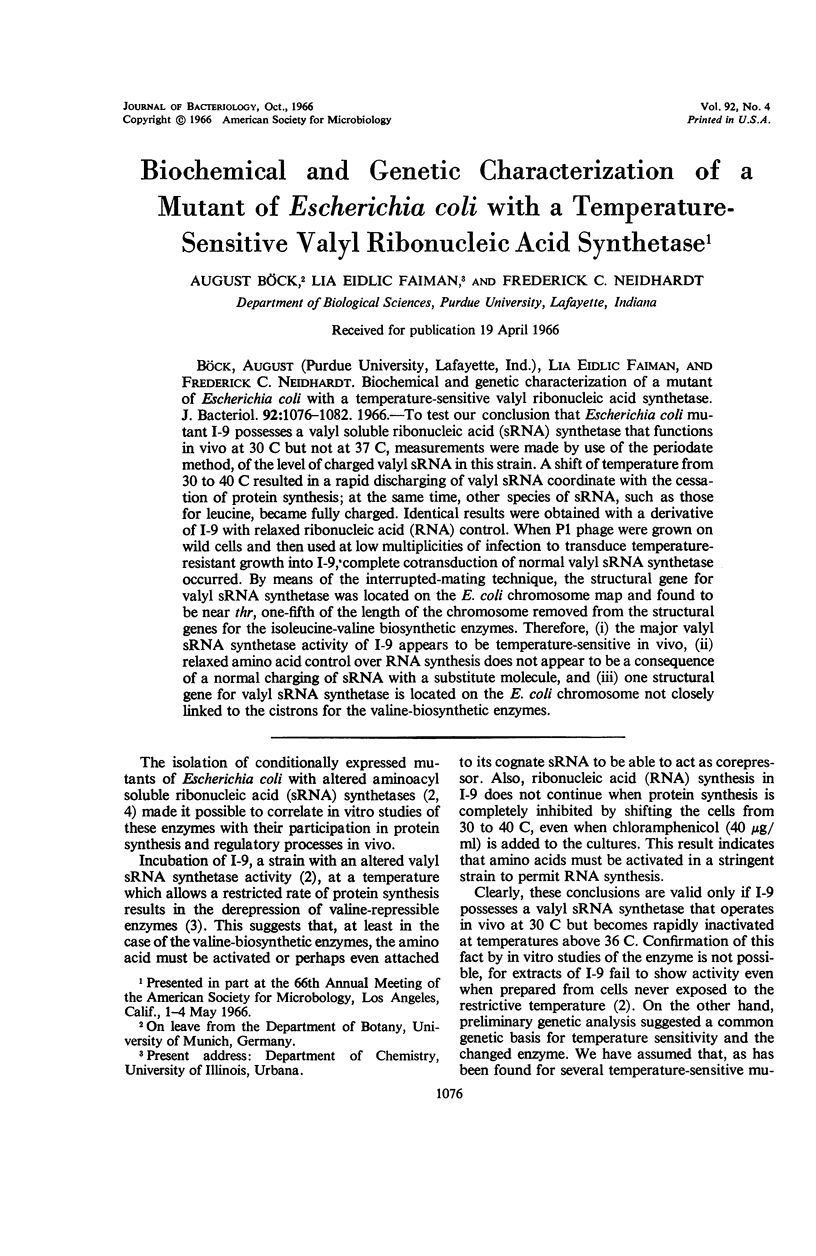

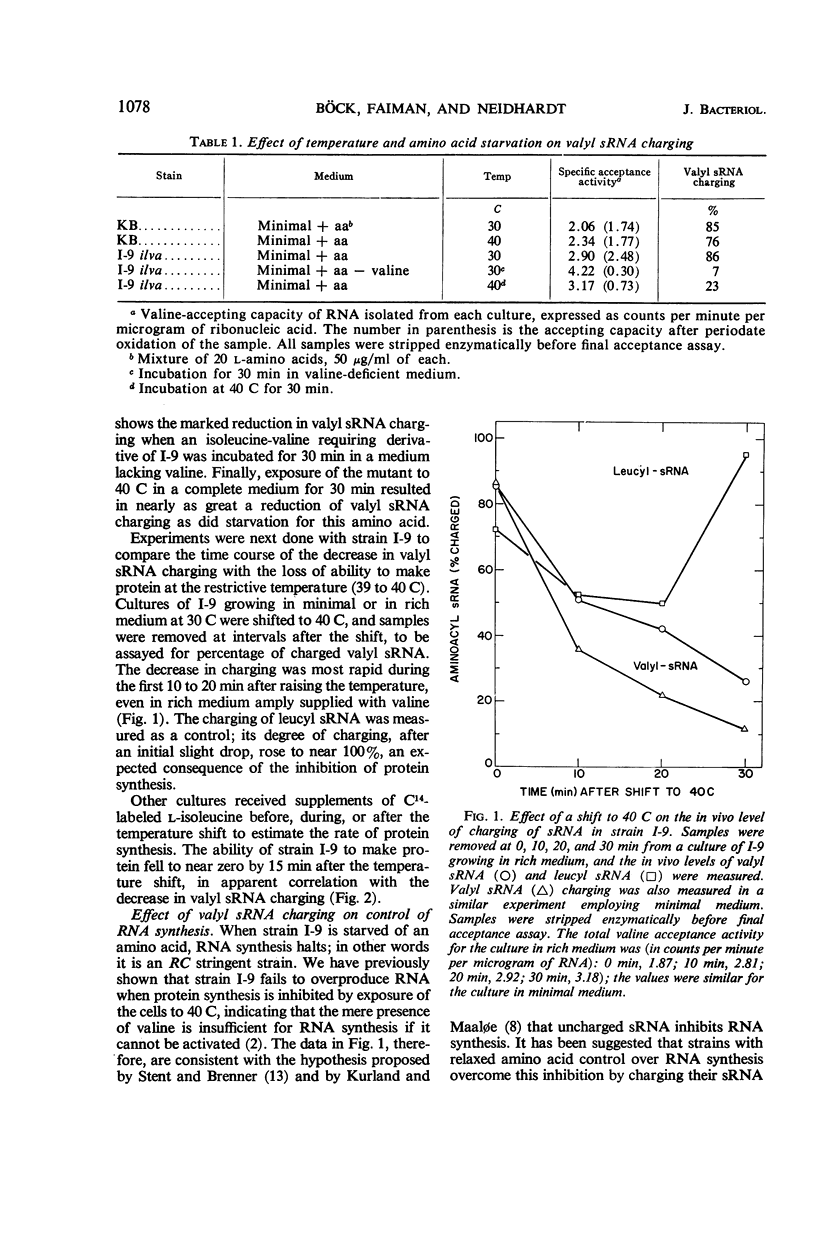
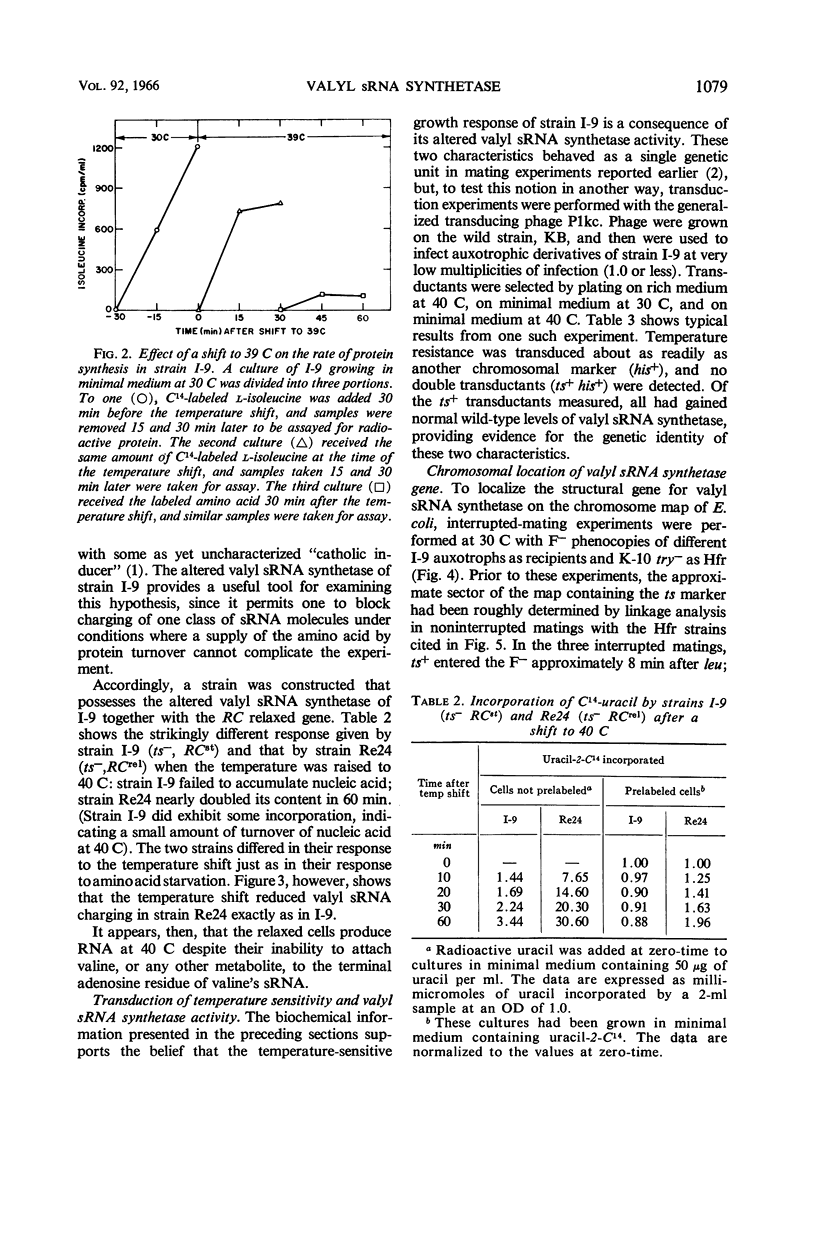
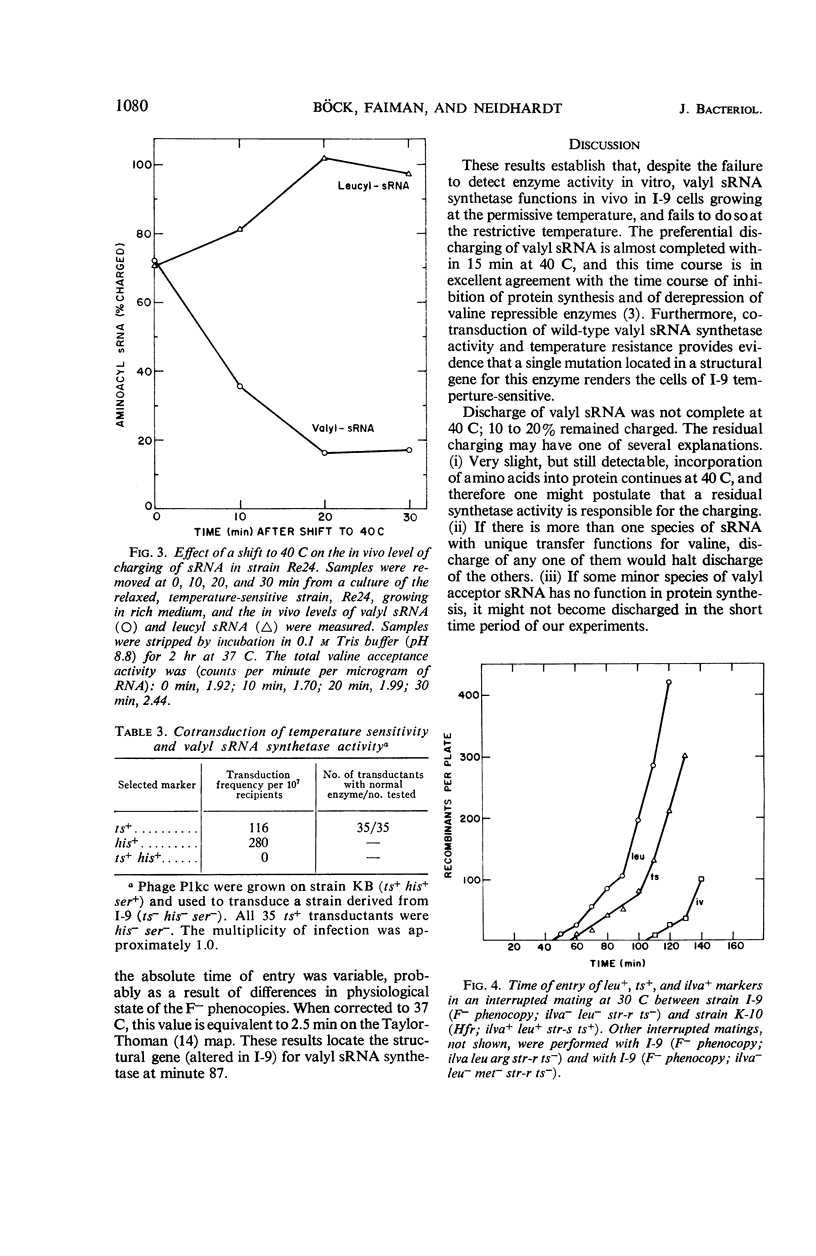
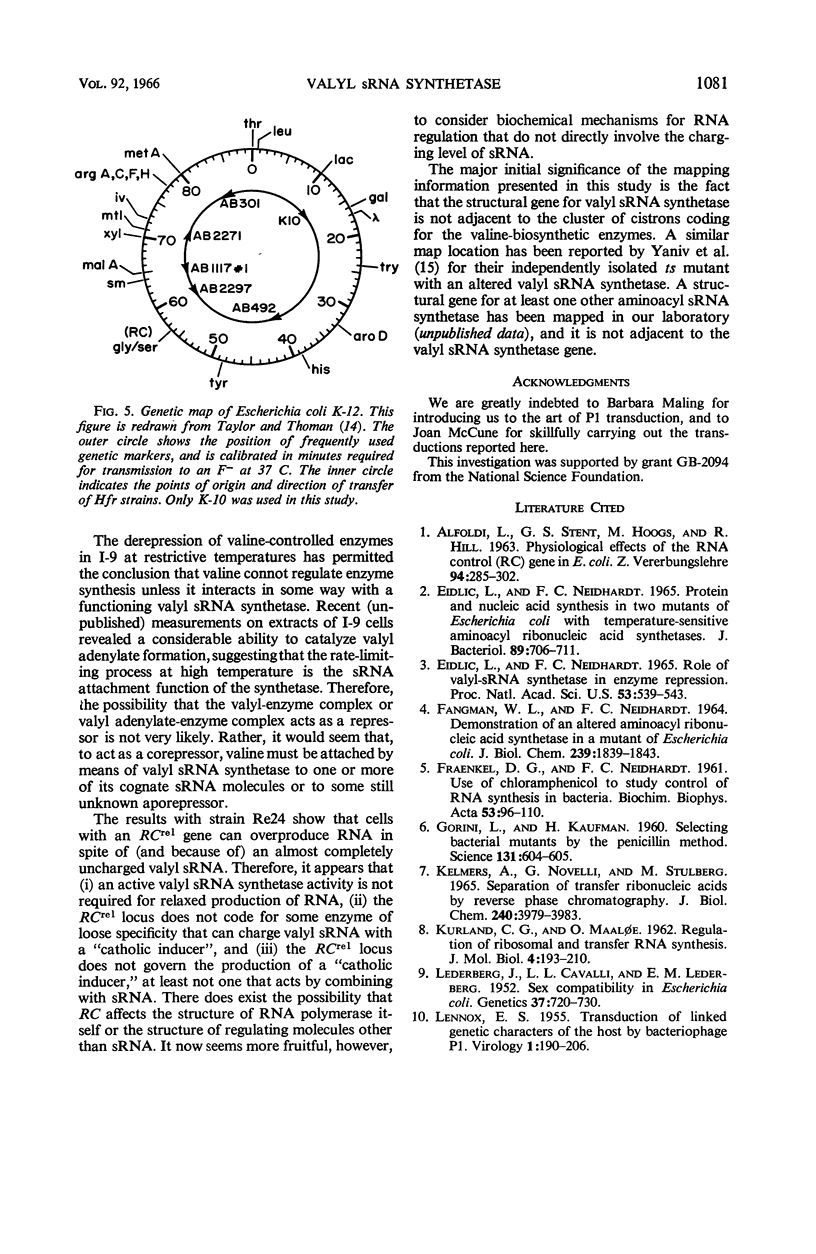

Selected References
These references are in PubMed. This may not be the complete list of references from this article.
- ALFOELDI L., STENT G. S., HOOGS M., HILL R. PHYSIOLOGICAL EFFECTS OF THE RNA CONTROL (RC) GENE IN E. COLI. Z Vererbungsl. 1963 Nov 21;94:285–302. doi: 10.1007/BF00894773. [DOI] [PubMed] [Google Scholar]
- EIDLIC L., NEIDHARDT F. C. PROTEIN AND NUCLEIC ACID SYNTHESIS IN TWO MUTANTS OF ESCHERICHIA COLI WITH TEMPERATURE-SENSITIVE AMINOACYL RIBONUCLEIC ACID SYNTHETASES. J Bacteriol. 1965 Mar;89:706–711. doi: 10.1128/jb.89.3.706-711.1965. [DOI] [PMC free article] [PubMed] [Google Scholar]
- EIDLIC L., NEIDHARDT F. C. ROLE OF VALYL-SRNA SYNTHETASE IN ENZYME REPRESSION. Proc Natl Acad Sci U S A. 1965 Mar;53:539–543. doi: 10.1073/pnas.53.3.539. [DOI] [PMC free article] [PubMed] [Google Scholar]
- FANGMAN W. L., NEIDHARDT F. C. DEMONSTRATION OF AN ALTERED AMINOACYL RIBONUCLEIC ACID SYNTHETASE IN A MUTANT OF ESCHERICHIA COLI. J Biol Chem. 1964 Jun;239:1839–1843. [PubMed] [Google Scholar]
- FRAENKEL D. G., NEIDHARDT F. C. Use of chloramphenicol to study control of RNA synthesis in bacteria. Biochim Biophys Acta. 1961 Oct 14;53:96–110. doi: 10.1016/0006-3002(61)90797-1. [DOI] [PubMed] [Google Scholar]
- GORINI L., KAUFMAN H. Selecting bacterial mutants by the penicillin method. Science. 1960 Feb 26;131(3400):604–605. doi: 10.1126/science.131.3400.604. [DOI] [PubMed] [Google Scholar]
- KURLAND C. G., MAALOE O. Regulation of ribosomal and transfer RNA synthesis. J Mol Biol. 1962 Mar;4:193–210. doi: 10.1016/s0022-2836(62)80051-5. [DOI] [PubMed] [Google Scholar]
- Kelmers A. D., Novelli G. D., Stulberg M. P. Separation of transfer ribonucleic acids by reverse phase chromatography. J Biol Chem. 1965 Oct;240(10):3979–3983. [PubMed] [Google Scholar]
- LENNOX E. S. Transduction of linked genetic characters of the host by bacteriophage P1. Virology. 1955 Jul;1(2):190–206. doi: 10.1016/0042-6822(55)90016-7. [DOI] [PubMed] [Google Scholar]
- Lederberg J, Cavalli L L, Lederberg E M. Sex Compatibility in Escherichia Coli. Genetics. 1952 Nov;37(6):720–730. doi: 10.1093/genetics/37.6.720. [DOI] [PMC free article] [PubMed] [Google Scholar]
- Morris D. W., DeMoss J. A. Role of aminoacyl-transfer ribonucleic acid in the regulation of ribonucleic acid synthesis in Escherichia coli. J Bacteriol. 1965 Dec;90(6):1624–1631. doi: 10.1128/jb.90.6.1624-1631.1965. [DOI] [PMC free article] [PubMed] [Google Scholar]
- Muench K. H., Berg P. Resolution of aminoacyl transfer ribonucleic acid by hydroxylapatite chromatography. Biochemistry. 1966 Mar;5(3):982–987. doi: 10.1021/bi00867a025. [DOI] [PubMed] [Google Scholar]
- STENT G. S., BRENNER S. A genetic locus for the regulation of ribonucleic acid synthesis. Proc Natl Acad Sci U S A. 1961 Dec 15;47:2005–2014. doi: 10.1073/pnas.47.12.2005. [DOI] [PMC free article] [PubMed] [Google Scholar]
- TAYLOR A. L., THOMAN M. S. THE GENETIC MAP OF ESCHERICHIA COLI K-12. Genetics. 1964 Oct;50:659–677. doi: 10.1093/genetics/50.4.659. [DOI] [PMC free article] [PubMed] [Google Scholar]
- Yaniv M., Jacob F., Gros F. Mutations thermosensibles des systèmes activant la valine chez E. coli. Bull Soc Chim Biol (Paris) 1965;47(8):1609–1626. [PubMed] [Google Scholar]


